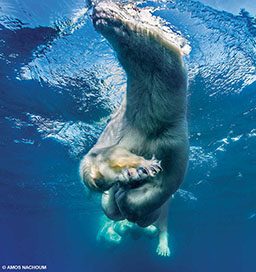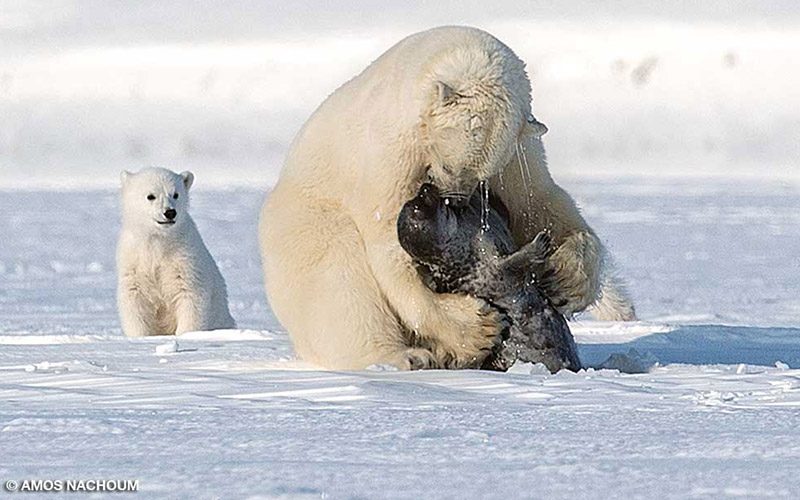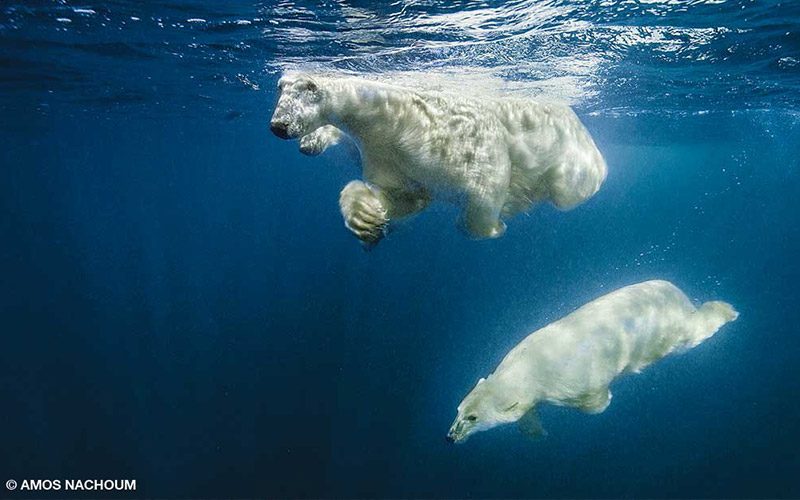My life began in Israel, far from the polar latitudes. But in the sweltering days of my youth I dreamed of the polar bears, icebergs and Inuit of the high Arctic. I became obsessed with the vision, and I made it my life’s mission to observe, study and understand Ursus maritimus — the polar bear.
A half century later I am in Svalbard, hoping to document female polar bears nursing their cubs and hunting. Late spring is when to find mothers with cubs; having recently given birth, the mothers will be wandering about the shrinking pack ice hunting for sustenance.
Polar bears’ range is largely within the Arctic Circle, which encompasses the Arctic Ocean, its sea ice and its surrounding seas and land masses. Although polar bears are typically born on land, they spend most of their time on sea ice. They hunt at the ice edge and live primarily off their fat reserves when no sea ice is present.
These bears have evolved to occupy a narrow ecological niche: They are highly adapted to the cold and capable of covering great distances over snow, ice and open water. They’re also very adept at hunting seals, which make up most of their diet. Because of expected habitat loss in the changing global climate, the International Union for Conservation of Nature and Natural Resources (IUCN) has classified polar bears as “vulnerable,” and at least three of the 19 polar bear subpopulations are currently in decline.
Each day we set out on snowmobiles with camera gear and enough food and clothing for 12 to 14 hours. We synchronized our days to optimal light and the bears’ hunting patterns. There are no words to describe the experience of driving fast through totally white hills, moving from one fjord to the next and stopping every so often to take in the amazing landscape before us — it engendered a profound feeling of being alive.

On the third day our guide, Einar, spotted movement about two miles away. Through his balaclava he whispered, “Mother and cub.” I looked through my binoculars and beheld the remarkable vision of a bear moving slowly along the ice with two cubs strolling behind her. They sniffed the air and the ground, trying to find a seal hole. Our guide calculated the wind direction and set about determining our best position with regard to light and proximity.
For the next three hours we shadowed the family. Before long the mother bear stopped to sit. She exposed a black nipple to nourish the cubs with her milk. We closed the distance to 100 yards, and I quietly set up a tripod on the ice and mounted my camera’s 600mm lens to capture this tender moment among apex predators (see Page 6). The feeding lasted for about 15 minutes, and then the family fell asleep on the ice right in front of us. We had no choice but to stay put until the two rambunctious cubs began chasing each other and the somnambulant mother moved them on their way again. Only then could we move as well.
The mother had to hunt. She would not have eaten during her pregnancy, and nursing two demanding young ones meant she needed food for them all. I saw her place her head close to the ice, sniffing, and then raise her head, close her eyes and sniff again. Einar informed us she was seeking a seal somewhere nearby.
Stopping his snowmobile, Einar went totally silent, picked up his binoculars and with a hand signal demanded we be still. The mother bear had positioned herself with her hindquarters in the air and her nose nearly touching the ice. Einar whispered to us that she was on high alert and that this was a good hunting hole. We would have to be extremely quiet as any sound above the ice would be amplified greatly beneath it. We could scare the seal away from the hole and cause the bear to lose her opportunity. Slowly and with great care we set up our cameras and tripods. For once I was wishing for those hot sunny days in Israel — I was freezing my butt off.

We had been there for almost two hours when suddenly the bear stood up tall and with lightning speed straightened her front legs and used them like a hammer to smash through the thick ice. Her rear legs went up in the air as her body plunged through the ice. Seconds later she was buoyed up in a big gush of water, holding a seal tightly in her powerful jaws. The circle of life was complete. The seal would provide the nutrition for the bear and her cubs, and, thanks to Einar, we were there as silent witnesses.
My obsession with polar bears likewise led me to the water. Eleven years ago I went in search of a diving adventure in the High Arctic, eager for an opportunity to dive with a polar bear. Upon spotting a bear, I planned to hang motionless in the frigid water at 30 feet, along with a safety diver, and wait for the bear to come toward us. At least that’s how I thought it might work out.
Instead, I entered the water to find the bear was already making its way toward me. Looking behind me for my safety diver, I discovered he was not there. Smart of him! When I turned back, the bear was only 10 feet away from me. At that point, my best move seemed to be to descend, but every time I looked up, the bear paws above my head loomed nearer. Cold fear entered my mind, but with each breath I took comfort in knowing I still lived.
We dived together, the bear and me, in a deadly race to the depths. I equalized as well as I could and purged all the air from my drysuit. A quick glance at my gauge told me I was at 80 feet, and that’s when the bear finally leveled off and began to ascend. I would survive to try to photograph a polar bear underwater another day, but the experience was terrifying. Back on the boat I discovered my safety diver had an equipment malfunction and had to abort. Would the polar bear have been so aggressive with two divers in the water? I’ll never know.
In August 2015 I finally had a chance to redeem myself with another attempt at the underwater polar bear encounter of my fantasies.
As luck would have it, a brilliant photographer and filmmaker from Israel, Yonatan Nir, had decided to produce a movie about my life and career in the company of ocean giants. He was aware of how important it was to me to get that underwater polar bear photo, for there are few such images in the world, and I had yet to get mine. We trekked back to the High Arctic accompanied by remarkably talented Arctic filmmaker and longtime friend Adam Ravetch and his team of Inuit guides.
We were finally able to set out to sea on the third day of our expedition; the first two days had been far too windy to safely be out in our boat. Our quest was to document a mother and her cubs swimming. We saw a single bear at first, but I passed on that option, thinking of my previous misadventure. A few hours later we spotted a female and her two one-year-old cubs climbing onto a small island. Our guides expected them to traverse the island and swim to the mainland. By the time we motored around the island, the family of three was already in the water.
We moved along slowly, 300 yards from the bears, trying to determine what direction they were headed. When it appeared their course was firmly set, Adam and I dressed for an in-water encounter, waiting until the last minute to splash to be sure we were in the bears’ path.

We stayed in place, treading water on the surface. As long as we could see the bears and they could see us, all was well. We remained where we were, and the trio continued swimming in our direction. So far, so good.
When the bear family got within 25 feet of us, we exchanged a thumbs-down signal and started our descent to 20 feet. We had 50-foot visibility and 40°F water (pretty good conditions, all things considered). During my slow descent I kept my eyes on the approaching bears, preparing to dive to safety if needed but hopeful to capture iconic images instead. Happily, the bear family swam peacefully over our heads. While Adam filmed and I photographed the passing bears, one of the cubs couldn’t resist diving down toward me for a closer look. It came within 3 feet, looked at me and left me in its wake to follow its mom and brother.
I hovered in the water, transfixed by the realization of what had just, finally, happened to me. The pursuit of this image had been more about the quest than the photo. My sense of what an in-water encounter with polar bears could be had been recalibrated. My personal mythology of the polar bear had a new dimension. I found myself considering our mutual vulnerability and envisioned a world in which the future of polar bears, Inuit culture and the pristine wilderness of the High Arctic could survive — even flourish.
Explore More
© Alert Diver — Q2 Spring 2016